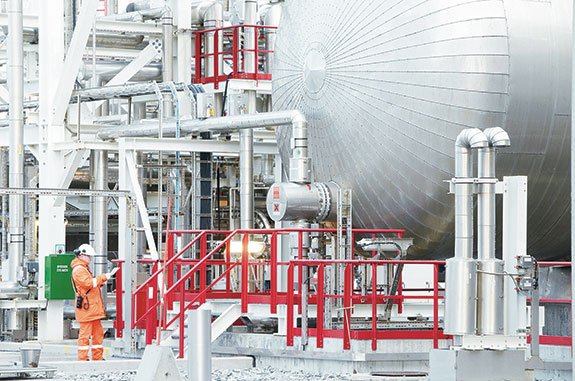Onshore lessons for offshore decommissioning
Published by David Bizley,
Editor
Oilfield Technology,
Philip Lawson, ABB Consulting, UK, challenges current views of decommissioning in the UKCS and looks at the lessons to be learned from shore-based projects.
The UK Continental Shelf (UKCS) has been producing oil and gas since the early 70s, with production peaking around 2000. The industry certainly at the outset did not envisage the engineering challenge it would face ahead of decommissioning these assets and the physical, economical and regulative roadblocks they would face. It is only in the past few years that industry has really put their heads together to determine the most economical methods to remove these assets from the UKCS. It has been a voyage of discovery for all concerned to decommission these huge pieces of steel, with estimated programme schedules overrunning by years rather than months and budgets far exceeding expectations.

Operators must learn from the experience of land-based decommissioning teams.
Contrary to widespread belief decommissioning is not a project. It is an integrated phase of the asset’s life. Operators will recognise that decommissioning is not something to postpone until cessation of production (CoP), it is something to actively and mindfully prepare for from project feasibility. It is important to think about decommissioning strategically, making sure you consider the people skills and technology needed to deliver it. As an industry, it has been acknowledged that to achieve the best outcome, decommissioning needs an approach that is interlinked with the remaining life of field (LoF) or asset.
To understand the challenges the industry faces, consider the list of assets that will face decommissioning in the next 30 years. They include of a variety of different structures, consisting mainly of production platforms supported by large gravity-based concrete foundations or steel frames ('jackets'). In addition to this, there are some smaller structures either floating on the surface or positioned on the seabed as well as interconnecting pipework and wells.
At present the total infrastructure that is estimated to require decommissioning from the UKCS consists of:
- Eight installations with large concrete substructures.
- 31 installations with large steel jackets (> 10 000 t).
- 223 other steel jackets.
- 280 subsea production systems.
- 21 floating production systems.
- Over 50 000 km of pipelines and around 10 000 wells.
This industry is still somewhat undeveloped and operators continue to rely on specialist expertise to guide them through this complex and evolving challenge. In order to obtain the necessary expertise within the many stages of a decommissioning programme, operators and owners often find themselves having to juggle several different suppliers, so it can become quite overwhelming and a burden to already stretched organisations.

The ABB Consulting team has distilled the decommissioning process and procedures into five key stages.
Has the offshore industry missed an opportunity to learn from the 30+ years of land-based decommissioning teams? Certainly, it is far easier to decommission assets onshore compared to offshore, since onshore is not constrained by POB and is very rarely delayed by adverse weather conditions. However they do face the same challenges of handling hazardous materials and ‘managing the unknown’. What the shore-based decommissioning teams do have, are very well developed, rigorous processes and procedures which have been fine-tuned through years of experience and most importantly early engagement with plants, long before the scheduled ‘lights go out’.
Even when decommissioning a small vessel or piece of pipeline early engagement is vital, in order to help the teams involved assess the hazards and risks thoroughly, ensuring as many of the risks and hazards are mitigated against or even eliminated.
How processes and procedures differ
As mentioned previously early engagement is seen as a critical step to ensure the success of fully decommissioned and dismantled assets within the proposed schedule and to a prescribed budget. So how early is early within the life of the asset to engage? Operators and owners are specifying that designers include features/characteristics to support or simplify decommissioning, but realistically for existing assets this is not going to be possible. So for existing assets the first place to start would to understand the current state of the assets and if available, what is on the decommissioning register and has it been decommissioned to the appropriate standard.
Onshore good practices include meticulous attention to maintaining the decommissioned register for the plant, along with regular audits to ensure that the register is up to date and it reflects the current state of the plant so the plant has no unknowns or uncertainties. Additionally developing a proven supply chain to support decommissioning programmes with mirrored procedures and contract terms & conditions will ensure that there are no weak links in the chain. This gives the owners and operators the confidence that from project ‘kick off’ to the final disposal of the last piece of material everything is auditable and complies with UK legislation, whether it be hazardous or non-hazardous waste.
It must also be considered that offshore legislation is the responsibility of The Department of Energy and Climate Change (DECC) and most of the regulations related to decommissioning of UK offshore oil and gas installations and pipelines using legislation under the Petroleum Act 1998, amended in the Energy Act 2008. In support of this, DECC provides guidance notes for decommissioning based on prior learning from previous decommissioning projects. In these notes DECC state that its policy regarding decommissioning can be summarised as follows:
“Government will seek to achieve effective and balanced decommissioning solutions, which are consistent with international obligations and have a proper regard for safety, the environment, other legitimate uses of the sea, economic considerations and social considerations. Our policies and practices on decommissioning will recognise the need to:
- Maximise energy production as a contribution to UK energy security.
- Take impacts on climate change into account.
These international obligations stem from the Convention for the Protection of the Marine Environment of the North- East Atlantic (the OSPAR Convention). This is the mechanism by which 15 governments of the western coasts and catchments of Europe, together with the European Community, co-operate to protect the marine environment of the North-East Atlantic. The original OSPAR Convention came into force on 25 March 1998 and is reviewed every five years.
Methodology and what does best practice look like?
Following 30+ years of decommissioning programmes the ABB team has distilled the process and procedures into five key stages to create a proven and robust methodology:
- Define scope of work – identify the boundaries for the activity.
- Preparation design detail planning, identification of risks.
- Procurement – engaging the optimum contractors.
- Onsite programme management and programme execution.
- Programme closeout.
Whether large- or small-scale decommissioning, onshore or offshore programme the five stage process is deployed to ensure all risks are identified and mitigated against. Behind each stage sits a series of processes and procedures that dovetail into each other and connect to the other stages. The key to success is not to stand still on every decommission programme; lessons can be learned and therefore processes and procedures are always updated to reflect best practices.

Operators recognise that decommissioning is not something to postpone until cessation of production (CoP).
The decommissioning lifecycle
The decommissioning lifecycle can be subdivided into many different elements, however it is fundamentally the five key phases shown below.
- Normal operation.
- Preparation for cessation of production.
- Decommissioning.
- Removal.
- Dismantling and disposal (including recycling reuse or landfill disposal).
Obsolescence
Within normal operation a further mini decommissioning lifecycle exists for equipment that has become obsolete, or surplus to requirements due to reservoir depletion. This particular area can affect the end decommissioning processes in many ways. The key aspect is if equipment is not decommissioned effectively or has been left in an unknown condition then the equipment may still contain hydrocarbons or unknown materials. If equipment, vessels or pipelines are left in an unknown condition then they have to be treated as hazardous and this could be where costs spiral out of control and schedules become elongated.
Shore-based experience has shown that not managing corroded platforms or stairs impacts the dismantling of equipment. It is therefore important that before equipment is allowed to corrode or become unusable due consideration is given to the decommissioning process. Too many cases in the UKCS recently have demonstrated that a poor strategy regarding postponing or even eliminating basic fabric maintenance has resulted in huge costs in either support scaffolding structures for corroded floors or in the worst case full reinstatement of excess stairwells to enable safe decommissioning. Once again it highlights the need to understand how the asset will be dismantled and the need to engage early.
One of the latest challenges to face the North Sea today is managing the material removed from the asset with legislation being tightened year on year and Scotland looking at a zero waste strategy for the UKCS. Not for profit organisation Decom North Sea has long been a proponent of smarter decommissioning, from reusing materials, pushing operators to think of decommissioning as a crucial part of the oil and gas operation and planning for materials’ extended lifetimes: enabling a new market of selling, leasing or hiring high performing products that can be used again. Maurice Golden, the Circular Economy Programme Manager for Zero Waste Scotland who is working alongside DNS noted that, “Many of these practices are already in place to some extent but we have an agenda to make them part of everyday business practice.” All of this requires early planning and engagement with the owner or co-operation of the operator, and to date very few have the appetite or resources to engage in with specialist companies to develop a lifecycle plan for decommissioning.
The most obvious material such as steel can be separated and recycled and some larger assets may be reused such as vessels in less hazardous applications. One of the cost saving lessons to learn from land based decommissioning is to identify upfront equipment that could be reused and to identify a potential buyer or market for the equipment to be sold. ABB has demonstrated on numerous occasions that money can be made from assets above and beyond the scrap value of the metal. In some cases it has been possible to achieve 1000% more than scrap value. In addition, identification of semi-precious materials hidden inside the structure of assets can maximise financial return.
To enable this equipment to be sold at values higher than scrap requires the asset to be preserved from the time it comes out of service, which requires planning, and as mentioned previously is all part of the overall decommissioning strategy for the platform or vessel.
References
- Decommissioning in the North Sea (A report of a workshop held to discuss the decommissioning of oil and gas platforms in the North Sea) by Royal Academy of Engineering (2012).
- ‘Golden Opportunities for Decommissioning’, DECOM North Sea, (May 2014).
Adapted by David Bizley
Read the article online at: https://www.oilfieldtechnology.com/special-reports/26032015/onshore-lessons-for-offshore-decommissioning/
You might also like
Amplus forms new partnership with VG Energy
The companies are working to bring together solutions to unlock lucrative marginal fields in West Africa.

